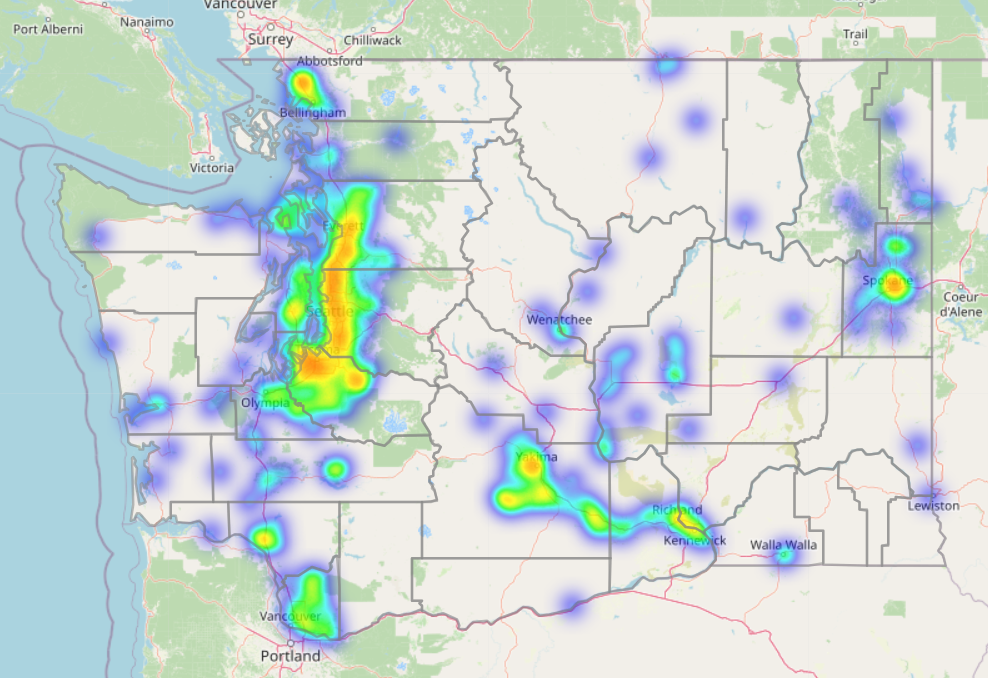Understanding firearm-related violence data is important in policymaking decisions. Using state and federal data sources, the Office of Firearm Safety and Violence Prevention created a resource to understand the impacts of firearm violence.
Understanding firearm violence data
You can’t fix what you don’t measure. Data is crucial for communities, researchers and policymakers to understand and mitigate firearm violence. Robust data can provide a foundation for improving evidence-based policymaking. Setting out the data responsibilities of OFSVP, the Legislature directed Commerce to:
• Work with law enforcement agencies, county prosecutors, researchers, and public health agencies throughout the state to identify and improve upon available data sources, data collection methods, and data-sharing mechanisms; and
• Identify gaps in available data needed for ongoing analysis, policy development, and implementation of evidence-based firearm violence intervention and prevention strategies.
OFSVP has partnered with researchers from the University of Washington Firearm Injury and Policy Research Program to compile an inventory and descriptions of existing sources of Washington firearms-related data. The inventory identifies 29 data sources in three main categories: health and healthcare, criminal justice, and firearm-related licensing and sales data. Through this early work, we have learned that — while many public health and public safety agencies track data related to firearms, firearm-related injuries and fatalities, and violent crime — that data is often collected and only accessible in silos. We are working with these partners to overcome these challenges.
Mapping community gun violence
Researchers have identified specific evidence-based practices to reduce community firearm violence. Other strategies have been developed to address other forms of firearm violence, including suicide and domestic violence. Data is crucial for helping identify which communities are experiencing higher rates of violence. OFSVP is working with those communities to coordinate and help implement evidence-based violence intervention and prevention strategies.

Visualizing firearm data
- OFSVP Firearm Data Dashboard (on Tableau) – The Firearm Data Dashboard provides information about fatal and non-fatal firearm injuries, lost and stolen firearms, attitudes about safe storage and background checks in Washington state. The data sets in the dashboard are based on available data sets from the Washington Department of Health, Washington Association of Sheriffs and Police Chiefs, the Behavioral Risk Factor Surveillance System, and the Federal Bureau of Investigation’s, National Instant Criminal Back Check System.
- Inventory of Firearm-Related Data Sets (on Tableau) – This provides links to 29 public health and criminal justice data sets.
Linking data sources
Moving forward, OFSVP will continue to engage with the owners and users of Washington’s firearm-related data systems to explore and identify steps to improve the availability and quality of firearm data in Washington through information collection and data sharing. As we bridge barriers created by traditional boundaries of local and state agencies, we must recognize and respect sensitivities surrounding the data, including health, law enforcement or other confidentialities.
Local public health and law enforcement agencies are key partners in providing information about firearm violence in their communities. OFSVP provides resources and linkages to reports, dashboards, and fact sheets, connecting data when possible. Under the Regional Data Resources section are links that connect to additional firearm-related data in select counties in Washington state.
Firearm injury is a major public health issue in the United States, yet there is limited data on firearm violence, including fatal and nonfatal shootings. National homicide data available through vital records reported by the National Violence Reporting System (NVDRS) provides some information about firearm-related deaths. However, public information is heavily aggregated and limited in its usefulness to explain firearm violence’s totality and impacts on the community.
Public health and criminal justice data measuring firearm violence can provide information about the totality of where and why firearm violence occurs, leading to new policies to support community safety. The challenge in the data systems is that data is separated, aggregated and in siloes. These barriers to both data availability and accessibility prevent a complete picture about firearm violence.
The Office of Firearm Safety and Violence Prevention dashboard presenting public health data related to firearm violence is located on Tableau Public. This dashboard uses a public health perspective from Washington public health data, law enforcement and federal data sources listed below. Each data source can provide insight into the total picture of firearm violence, who firearm violence impacts, the circumstances of why instances occur, attitudes about safe storage, lost and stolen firearm data and background check information to acquire a firearm.
Additional resources for public health data
- The Washington State Department of Health Rapid Health Information Network (RHINO), Health Center for Health Statistics, and the Violence Death Reporting System (WA-VDRS), and Behavioral Risk Factor Surveillance System (BRFSS).
- Washington Association of Sheriffs and Police Chiefs (WASPC). Provides data compiled from data submitted to the Washington State Uniform Crime Reporting Program.
- Federal Bureau of Investigations (FBI), National Instant Criminal Background Check System (NICS). This national system provides reports and statistical data on firearm background checks.
- CDC Wonder (CDC.gov) provides mortality and population data compiled by the National Center for Health Statistics at the Centers of Disease Control and Prevention (CDC). Mortality information is collected from state registries and provided to the National Vital Statistics Systems.
- The CDC’s Web-based Injury Statistics Query and Reporting System (WISQARS) is an interactive, online database that provides fatal and nonfatal injury, violent death and cost of injury data. Researchers, the media, public health professionals, and the public can use WISQARS™ data to learn more about the public health and economic burden associated with unintentional and violence-related injury in the United States.
OFSVP strives to connect local firearm data in Washington. Please review additional county-related firearm data from the following counties.
- State Data: Washington | Center for Gun Violence Solutions
- Rand Study, Gun Policy in America
- Inventory of Firearm Data for Washington State (PDF)
- University of Washington Firearm Injury & Policy Research Program
- ATF National Firearms Commerce and Trafficking – WA Crime Guns Data Report
- King County Gun Violence Data – Crime Strategies Unit
- King County – Stolen Firearms Reported to Law Enforcement Data
- King County – EMS Incidents Involving Firearm Injuries
- Everytown Research and Policy – The Economic Cost of Gun Violence

